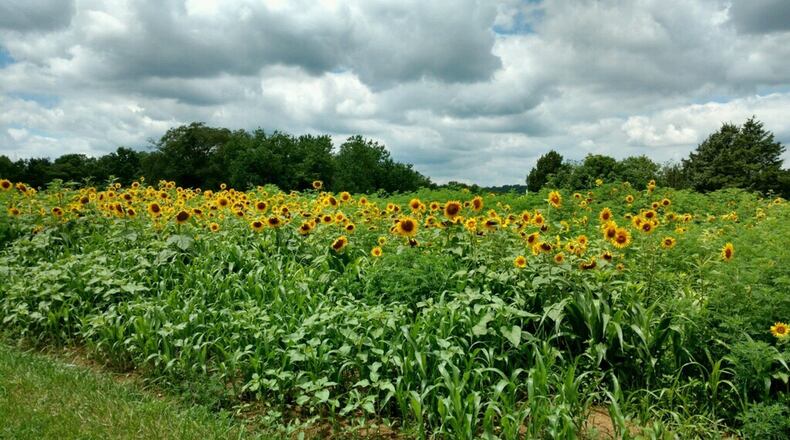Landowners can use the money however they want, “but most reinvest it in their farm operations,” according to information on the program’s website.
Promoters point to benefits beyond the financial in preserving the land, while skeptics urge caution.
The $240,814 allotted in Warren County in 2019 is a third less than was paid to the Dobbs family for an easement on their Two Bar D Farm, near the Warren-Clinton county line.
MORE: Farmland values drop 24 percent in Montgomery County
With former farms selling for as much as $90,000 an acre, according to an area expert, the monetary payback of the easement program is dwarfed by the potential returns for those ready to take the money and move.
Still, Shane Dobbs said he was happy to have sold a preservation easement to 106 of 118 acres of his land, along Todd’s Fork near the Warren-Clinton County line for $332,000 — about $300,000 after expenses. The net gain is about half the appraised value, according to the Warren County Auditor’s Office.
“I have given up all development rights to my farm,” Dobbs said last week. “I hope it becomes our legacy.”
The easements are funded through the Clean Ohio Conservation Fund, approved by voters in 2008 under the state’s Local Agricultural Easement Purchase Program.
“The easement requires the farm remain permanently in agriculture production. Selected farms must be 40 acres or more, actively engaged in farming, participate in the Current Agricultural Use Valuation program, demonstrate good stewardship of the land, have the support of their local government and not lay directly in the path of development,” according to the Ohio Department of Agriculture.
MORE: Warren County growth debate sparks referendum
In Montgomery County, $304,451 is available and in Miami County, $320,361, through that counties' soil and water conservation districts.
In Butler and Preble counties, applications for up to $421,651 can be made to the Three Valley Conservation Trust. In Greene and Clark counties, the Tecumseh Land Trust is handling applications for $441,534.
MORE: Farmland preservation efforts seeks to protect nearly 3,800 acres
Warren County Soil and Water Conservation District is the sponsor in Warren County.
Seminars are held by sponsors to explain how easements are considered and prices determined through a competitive process. The process can take several years, and easements typically are one-third the current resale value, according to Dobbs, also formerly a sponsor board member.
“In our case, the assessed value was far greater than the funds available,” Dobbs said. “but we decided it was time to move forward.”
MORE: Former family farm rezoned for subdivision in Warren County
Joe Kramer, an executive vice president with the Schueler Group, an integrated real estate development company based in Lebanon, cautioned property owners tempted to sign up for an easement.
Kramer said an acre of land sold for development was worth at least $20,000 and as much as $90,000, if zoned for high-density housing, located in a popular community with good schools and adequately served by water and sewer systems.
“It’s a very permanent decision,” Kramer said last week. “It’s hard to say what will happen five, 10 years in the future.”
Kramer said those choosing to preserve their land for agricultural use aren’t “thinking in monetary terms. It generally tends to be an emotional attachment to the land that drives the decision.”
Dobbs said he comes from five generations of farmers and his wife was raised on a 2,300-tree orchard. He traced his interest in the program back about 10 years, when the real estate market was hot, before the bubble burst that helped cause the Great Recession.
MORE: Warren County planning development of 25 acres between Dayton, Cincinnati
“The economy took such a downturn, development was not really a threat,” Dobbs said, recalling he began attending seminars on the program in 2014.
Their easement was approved in April.
He noted that although the land must continue to be farmed, it can be sold.
He agreed with Kramer on at least one point. “It’s not anything to be done or taken lightly,” said Dobbs, an engineer operating a cabinetry business.
MORE: Interchange development plan anticipates World Heritage status
Easement holders are subject to annual inspection to ensure agriculture continues on the property.
“As stewards of the land, we are responsible for soil and water quality management as well as forest management, selectively cutting timber and controlling invasive species,” he said.
Dobbs said he was delighted to be preserving the land, half of which he leases to a local producer who raises corn and soybeans.
Pastures, woods, streams and ponds, including frontage on Todd’s Fork, a Little Miami tributary, comprise the rest.
“It’s very picturesque,” he said. “In Warren County, it’s becoming very rare.”
HOW TO LEARN MORE
2019 Farmland Preservation Program
Tuesday, Dec. 18, 4-6 p.m.
320 E. Silver St., Lebanon, Room 20 (downstairs)
For more information, call 513-695-1337, extension 2530, or email cindy.meyer@co.warren.oh.us
About the Author

